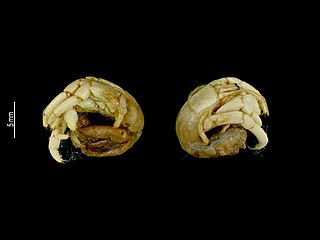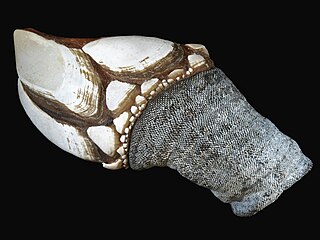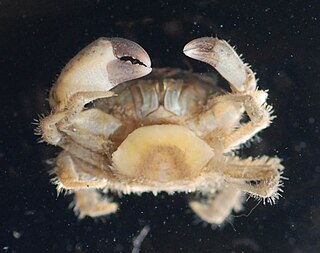| Dipterosaccus | |
|---|---|
| Scientific classification | |
| Domain: | Eukaryota |
| Kingdom: | Animalia |
| Phylum: | Arthropoda |
| Class: | Thecostraca |
| Subclass: | Cirripedia |
| Infraclass: | Rhizocephala |
| Family: | Peltogastridae |
| Genus: | Dipterosaccus Van Kampen & Boschma, 1925 |
| Dipterosaccus | |
|---|---|
| Scientific classification | |
| Domain: | Eukaryota |
| Kingdom: | Animalia |
| Phylum: | Arthropoda |
| Class: | Thecostraca |
| Subclass: | Cirripedia |
| Infraclass: | Rhizocephala |
| Family: | Peltogastridae |
| Genus: | Dipterosaccus Van Kampen & Boschma, 1925 |

Sacculina is a genus of barnacles that is a parasitic castrator of crabs. They belong to a group called Rhizocephala. The adults bear no resemblance to the barnacles that cover ships and piers; they are recognised as barnacles because their larval forms are like other members of the barnacle class Cirripedia. The prevalence of this crustacean parasite in its crab host can be as high as 50%.

Barnacles are a type of arthropod constituting the subclass Cirripedia in the subphylum Crustacea, and are hence related to crabs and lobsters. Barnacles are exclusively marine, and tend to live in shallow and tidal waters, typically in erosive settings. Around 1,000 barnacle species are currently known.

Rhizocephala are derived barnacles that parasitise mostly decapod crustaceans, but can also infest Peracarida, mantis shrimps and thoracican barnacles, and are found from the deep ocean to freshwater. Together with their sister groups Thoracica and Acrothoracica, they make up the subclass Cirripedia. Their body plan is uniquely reduced in an extreme adaptation to their parasitic lifestyle, and makes their relationship to other barnacles unrecognisable in the adult form. The name Rhizocephala derives from the Ancient Greek roots ῥίζα and κεφαλή, describing the adult female, which mostly consists of a network of thread-like extensions penetrating the body of the host.

Chthamalus is a genus of barnacles that is found along almost all non-boreal coasts of the northern hemisphere, as well as many regions in the southern hemisphere. These small barnacles have been studied in part because of the taxonomic confusion over a group of species that, by and large, are morphologically and ecologically quite similar. In recent years, molecular techniques have identified a number of cryptic species that have been subsequently confirmed by taxonomists using morphological measurements. Most recently the genus has been shown to be paraphyletic, with the genus Microeuraphia nested within Chthamalus.

The Sacculinidae are a family of barnacles belonging to the bizarre parasitic and highly apomorphic infraclass Rhizocephala. The Sacculinidae is one of the two larger families of Rhizocephala, containing six genera:

The Peltogastridae are a family of barnacles belonging to the bizarre parasitic and highly apomorphic infraclass Rhizocephala. The Peltogastridae are by far the largest family of Rhizocephala. They comprise 14 genera, 3 of which were moved from the family Lernaeodiscidae.

Pollicipes is a genus of goose barnacles, first described by William Elford Leach in 1817. It comprises four species of marine suspension-feeders.

Chelonibia is a genus of acorn barnacles in the family Chelonibiidae of the subphylum Crustacea. Its members are epizootic and live attached to manatees, turtles, marine molluscs, crabs and horseshoe crabs in all tropical and subtropical oceans. In a few instances, they have been found on sea snakes, alligators and inanimate substrates, but they are not found in the typical habitats of barnacles – on rocks, docks or boats.
Conopea is a genus of barnacle, containing the following species:
The Catophragmidae are a family of barnacles in the superfamily Chthamaloidea with eight shell wall plates, surrounded by several whorls of imbricating plates. The basis is membranous.
Pieter Nicolaas van Kampen was a Dutch zoologist.
Oxynaspis is a genus of goose barnacles in the order Lepadiformes.

Heterosaccus is a genus of barnacles in infraclass Rhizocephala. Like other taxa in this group, they parasitize crabs. Geoffroy Smith circumscribed the genus in 1906; he initially only included H. hians. Smith circumscribed a genus distinct from Sacculina due to a difference of the mesentery; in Heterosaccus, the mesentery does not stretch down to the mantle opening but rather only is present on the ring of attachment.
Polyascus is a genus of barnacles in infraclass Rhizocephala. It was circumscribed in 2003 by Henrik Glenner, Jørgen Lützen, and Tohru Takahashi. They included three species, all transferred from Sacculina. The generic name polyascus refers to the typical presence of multiple external sac-like female bodies, known as externae. In Polyascus species, these originate from asexual reproduction.

Christa Laetitia Deeleman-Reinhold is a Dutch arachnologist. She specializes in spiders from Southeast Asia and Southern Europe, particularly cave-dwelling and tropical spiders. She donated a collection of about 25,000 Southeast Asian spiders, the largest collection of Southeast Asian spiders in existence, to the Naturalis Biodiversity Center in Leiden. In addition to numerous articles, she has written the book Forest Spiders of South East Asia (2001).

Clistosaccidae is a family of parasitic barnacles belonging to the bizarre and highly apomorphic infraclass Rhizocephala, which is part of the barnacle subclass Cirripedia.

Peltogasterella is a genus of parasitic barnacles in the family Peltogasterellidae. There are at least four described species in Peltogasterella.

Loxothylacus is a genus of parasitic barnacles in the family Sacculinidae. There are more than 20 described species in Loxothylacus.

Triangulus is a genus of parasitic barnacles in the family Triangulidae, the sole genus of the family. There are at least four described species in Triangulus.